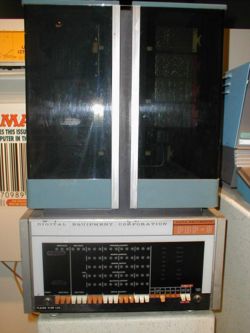PDP-8
From Computer History Wiki
This article is about the first PDP-8, which had that name. For information about PDP-8's in general, see PDP-8 family.
| PDP-8 | |
 An original, transistorized PDP-8 | |
| Manufacturer: | DEC |
|---|---|
| Architecture: | PDP-8 |
| Year Introduced: | 1965 |
| Year Discontinued: | 1969 |
| Form Factor: | minicomputer |
| Word Size: | 12 bits |
| Design Type: | clocked random logic |
| Clock Speed: | 333KHz |
| Memory Speed: | 1.5 μseconds |
| Physical Address Size: | 32KW (requires optional Type 183) |
| Virtual Address Size: | 4KW |
| Memory Management: | bank select |
| Bus Architecture: | Negative I/O Bus |
| Predecessor(s): | PDP-5 |
| Successor(s): | PDP-8/I |
| Price: | US$18,500 |
The PDP-8 was DEC's major breakthrough, and now considered the first successful minicomputer. It was, by a significant amount, the cheapest computer yet made at the time. The PDP-8 was constructed with discrete transistors, packaged into DEC's FLIP CHIP technology.
Operating Systems
The PDP-8 could run various operating systems including:
Emulators
There are various emulators for PDP-8 systems including:
| v • d • e PDP-8 Computers, Software and Peripherals |
|---|
| PDP-8s: PDP-5 • PDP-8 • LINC-8 • PDP-8/S • PDP-8/I • PDP-8/L • PDP-12 • PDP-8/E • PDP-8/F • PDP-8/M • PDP-8/A
Workstations: VT78 Also: PDP-8 family • PDP-8 architecture • PDP-8 Memory Extension units |